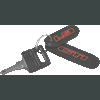-
Posts
19 -
Joined
-
Last visited
Content Type
Profiles
Forums
Calendar
Gallery
Everything posted by jackherer
-
My mates Alfa 166 had a snapped spring on the OSF. It drove perfectly despite this, I drove it to the MOT centre that failed it and I didn't notice anything amiss. It was nowhere near as bad as this Vauxhall but it was completely snapped, the top two coils were totally separate. I normally work on 80s Peugeots and I have never seen a Pug spring with any significant corrosion, my mates Alfa is a '99 on 60k so I was surprised to say the least. I ended up fitting a full set of Eibachs as they cost less than just the fronts from Alfa, and once the rears were off it was obvious they needed changing too. I understand it was recently aligned at WIM on my recommendation.
-
Citroen used them as well (they are the same company after all) and the wheelbase change you mentioned is the reason Citroens with hydraulic suspension have the handbrakes fitted to the front wheels. When they are left parked for long periods the suspension drops all the way down to the bumpstops, the front mac struts just go straight down but the rear trailing arms travel through an arc so if the rear wheels were braked the body (and front wheels) would move to compensate for the wheelbase change. I only mention this as it helped me visualise the theoretical wheelbase change with my stiffly sprung* 205 GTI when I moved the suspension of one of my Citroens through its full travel. *not coil springs, torsion bars, big fat 23mm ones
-
Tony wants you to write this in English:
-

I just bought some new coilovers, and they're inverted :D
jackherer replied to jon's topic in Suspension
Its lucky I learned a thing or two from your site and fixed it myself rather than bringing it in to you then - would have been a definite for 'Horror Of The Week' -

I just bought some new coilovers, and they're inverted :D
jackherer replied to jon's topic in Suspension
It was quite bad as I really had no idea what I was doing back then... Also its a track spec 205 gti with an LSD, thicker torsion bars and high poundage springs, Gaz gold dampers, thicker ARBs, a multipoint weld in cage etc and little changes can really upset it. -

I just bought some new coilovers, and they're inverted :D
jackherer replied to jon's topic in Suspension
I'm specifically talking about when the rack is off centre via the steering arms because the orientation of the steering wheel has been used as the datum for the centre of the rack. I.E. when someone has put the steering wheel on at random then had a low end tyre place set the toe so both wheels point forward when the steering wheel is straight. So to rephrase my question, how often do you have to remove the steering wheel and replace it so its straight after aligning the chassis? I imagine the fitting of airbags reduces this issue as people are less likely to take their own steering wheels off. -

I just bought some new coilovers, and they're inverted :D
jackherer replied to jon's topic in Suspension
I see so many old 205 GTIs that people have done that to. There is only one position on the rack for the wheel to be put on, if its moved to compensate for alignment issues you end up with more steering lock one way compared to the other but also, as the track rods have to be adjusted to differing lengths to compensate, you can get weird bumpsteer and ackermann related issues with heavier steering in one direction than the other. The first thing I do in an old car now is check if the steering wheel goes to the same (but opposite) angle at each lock, I realise its not very accurate but it gives you an idea. I have heard that some cars (Porsches?) have a slot in the steering rack so a locking pin can be inserted when it is exactly centred so you can put the steering wheel on in the right place. Why don't all cars have something like this? Tony, is an uncentered rack/mispositioned steering wheel a fault you encounter often with home built/DIY repaired cars? A while ago I took my 205 that I built from a bare shell to several alignment places who all failed to spot my uncentered rack, I then did some googling and learned a bit about alignment from sites including this one and then managed to persuade my local MOT centre to let me use their ramp and laser tracker myself to get it centered then get the toe set which absolutely transformed the car from barely driveable to stuck to the road! -
They are due to small holes in the mould that excess rubber flows into when they are made. Modern tyres generally don't have them though, apart from maybe a few on the sidewalls. I haven't seen a tyre like that since I was a small child!
-
I imagine that will be a pleasant side effect but the ackermann change is the main benefit?
-
Zero ackermann for drift has always made sense to me, ackermann is for turning and drifting isn't turning, the front wheels are pretty much pointing where the car is going so there is no benefit to adding extra toe when the steering wheel is turned.

